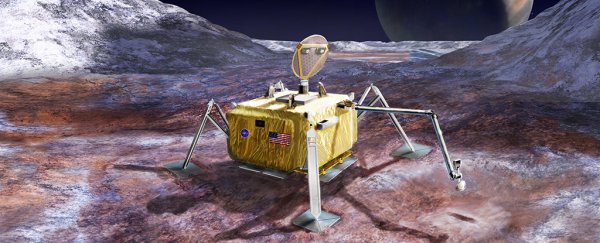Is there life on Europa – that scarred, icy moon orbiting Jupiter? NASA is determined to find out, with the space agency having just revealed plans to drill into the moon's crust in search of extraterrestrials.
A new report details plans for a lander that could drill roughly 10 cm (4 inches) deep into the moon's surface, and analyse samples using on-board instruments to give researchers vital information on what Europa's made up of, and whether life could flourish there.
Despite several fly-bys, there's still a lot we don't know about the environment on the icy moon, so the probe will have to deal with unexpected conditions on the ground.
But the researchers think they've cracked it with their new lander concept, and the mission could be on its way by 2024, with a 2031 arrival date.
"I think it's a great design," astronomer Jonathan Lunine told Rae Paoletta at Gizmodo.
"I was skeptical that we could in fact design a payload with a reasonable technological maturity and relative simplicity. Thanks to the engineers, a very practical solution was found and the payload we put together is not overly ambitious."
"The bottom line is I became much more of a believer that this is a mission that can be done in a time frame I'd be interested, in the next 20 years or so," he added.
That design includes a camera system for taking snaps of the surface, and various instruments for live analysis – including a high-gain antenna for communications, and a geophone to monitor geological activity.
Another bit of kit included in the 42.5-kg (93.7 lbs) payload is a Separation-Mass Spectrometer system, which will be used to identify the chemical make-up of samples through the process of ionisation.
The researchers are especially keen to find biosignatures – signs of past or present life hidden in elements like isotopes and molecules.
As well as looking for life on Europa, the lander will be tasked with assessing the potential habitability of the moon, and capturing information to help scientists design successor robots to visit Europa in the future.
One of those future missions could eventually drill right down to the moon's underground ocean, thought to be at least 19 kilometres (11.8 miles) below the surface.
While we don't know for sure that this underground body of water exists on Europa, the evidence strongly suggests that it does. And usually, where water is found, life follows, which is what makes Europa one of the most promising locations in our Solar System for finding alien life.
We should get plenty more useful data about the moon from the fly-by NASA has planned to take place early in the 2020s. Any information sent back from that trip can be used to tweak the design of the lander further.
By publishing its new 264-page report, the team is hoping to get feedback from the scientific community on what might work and what might not in the proposed lander design.
If the plans get the go-ahead from NASA and its partners, the robotic lander could be on its way through space within the next decade – and even if it doesn't find life on Europa, it should still discover a treasure trove of useful material for scientists.
"This mission would significantly advance our understanding of Europa as an ocean world, even in the absence of any definitive signs of life," the researchers explain in their report, "and would provide the foundation for the future robotic exploration of Europa."
The report is available on NASA's website.
